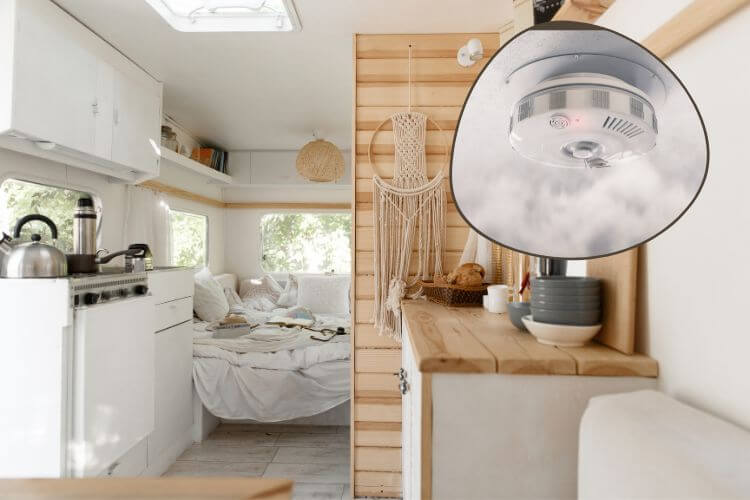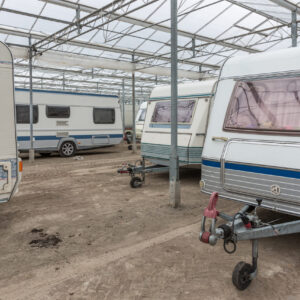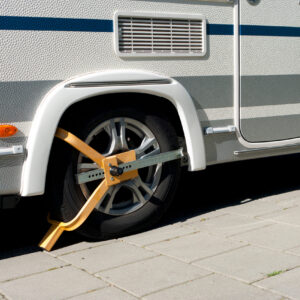When it comes to ensuring the safety of everyone in a caravan, installing smoke alarms and heat detectors is a must. These devices can provide early warning in case of a fire, giving occupants enough time to evacuate and call for help.
However, knowing where to position these devices can be tricky, especially in a small and confined space like a caravan.
According to experts, the ideal location for a smoke alarm in a caravan is on the ceiling of the living area, as close as possible to the sleeping area.
It is important to avoid placing it in the kitchen or bathroom, as steam and condensation can trigger false alarms. As for heat detectors, they are usually installed in areas that often feature dust or smoke that may otherwise set off a standard smoke detector.
It is worth noting that the regulations regarding smoke alarms and heat detectors in caravans vary by state or territory.
In some places, it is recommended to install a caravan-specific smoke alarm with a hush button, while in others, it is required by law to fit a smoke alarm regardless of where the caravan is registered.
Therefore, it is important to check the local regulations and guidelines before installing these devices.
Legal Requirements
When it comes to placing smoke alarms or heat detectors in a caravan, there are legal requirements that must be followed. The Caravan Sites and Control of Development Act 1960 requires that all caravans have a smoke detector installed.
The detector must be a suitable type and positioned in a location that will provide adequate warning to occupants in the event of a fire.
The British Standard recommends that smoke alarms should be installed in the circulation space between the sleeping area and the living area, as well as in the sleeping area itself. Heat detectors are recommended in the kitchen area to avoid false alarms from cooking fumes.
It’s important to note that the legal requirements for smoke alarms and heat detectors in caravans may vary depending on the country or region. It’s always best to check with the local authorities to ensure compliance with the regulations.
Placement of Smoke Alarms

When it comes to caravan safety, smoke alarms are a must-have. They can alert you to the presence of smoke or fire, giving you and your family enough time to evacuate safely. However, it’s important to know where to position them to ensure maximum effectiveness.
Living Area
The living area is where most people spend the majority of their time in a caravan. As such, it’s essential to have a smoke alarm in this area. It should be positioned on the ceiling, at least 30cm away from any wall or light fitting.
This will ensure that smoke is detected quickly, even if it’s coming from a corner of the room.
Kitchen
The kitchen is one of the most common areas for fires to start, so it’s crucial to have a smoke alarm here. However, it’s important to position it correctly.
Smoke alarms should be installed at least 10 feet away from any cooking appliance to minimize false alarms. If possible, position the alarm on the ceiling, away from the stove or oven.
Bedroom
It’s essential to have a smoke alarm in each bedroom of your caravan. This is because fires can start at any time, including when you’re sleeping. Position the alarm on the ceiling, at least 30cm away from any wall or light fitting.
If you have a bunk bed, make sure to install a smoke alarm on the ceiling near the top bunk.
Bathroom
While the bathroom may not seem like an obvious place to install a smoke alarm, it’s still important to have one here. This is because electrical faults can occur in the bathroom, which can lead to fires.
Position the smoke alarm on the ceiling, at least 30cm away from any wall or light fitting.
By following these guidelines, you can ensure that your caravan is equipped with smoke alarms in all the right places. This will give you peace of mind, knowing that you and your family are protected in case of a fire.
Placement of Heat Detectors
When it comes to caravans, heat detectors are an essential safety feature. They are designed to detect rapid increases in temperature rather than smoke, making them ideal for use in kitchens and boiler rooms where smoke detectors might produce false alarms.
Kitchen
The kitchen is one of the most important areas to install a heat detector in a caravan. It’s where cooking takes place, and there’s always a chance of a fire starting due to a mishap.
A heat detector should be installed on the ceiling, at least 50cm away from any wall or corner. This will enable it to detect any temperature changes in the kitchen quickly.
It is also important to avoid installing a heat detector too close to a cooking appliance, as this may cause false alarms. A minimum distance of 1.5 meters is recommended to avoid any unwanted alarms.
Boiler Room
The boiler room is another area where a heat detector should be installed. It’s where the caravan’s heating system is located, and it’s also where any gas appliances are situated.
A heat detector should be installed on the ceiling, at least 50cm away from any wall or corner. This will enable it to detect any temperature changes in the boiler room quickly.
It is also important to avoid installing a heat detector too close to a gas appliance, as this may cause false alarms. A minimum distance of 1.5 meters is recommended to avoid any unwanted alarms.
Maintenance

Smoke alarms in caravans should be maintained regularly to ensure that they are working correctly.
The following maintenance tips should be followed:
- Test the smoke alarm regularly by pressing the test button. This should be done at least once a month.
- Replace the batteries in the smoke alarm at least once a year, or as recommended by the manufacturer. It is a good idea to replace the batteries at the beginning of each camping season.
- Clean the smoke alarm regularly to remove any dust or debris that may have accumulated on the sensor. This can be done using a vacuum cleaner or a soft brush.
- Replace the smoke alarm every 10 years, or as recommended by the manufacturer.
It is important to keep a record of all maintenance performed on the smoke alarm. This can be done using a logbook or by keeping receipts for replacement batteries and smoke alarms.
Keeping a record of maintenance will help to ensure that the smoke alarm is working correctly and will also provide evidence of compliance with regulations in the event of an accident.
Conclusion
When it comes to caravan safety, smoke alarms and heat detectors are essential for protecting yourself and your loved ones.
While it is important to ensure that your caravan is fitted with the right type of smoke alarm or heat detector, it is equally important to position them correctly.
As per the regulations in NSW, Victoria and Northern Territory, a smoke alarm must be fitted in your caravan/RV regardless of where it is registered. It is recommended that you install a caravan specific smoke alarm with a hush button.
When positioning your smoke alarm or heat detector, it is best to install it in the centre of the ceiling, away from walls and light fittings/decorative objects.
This is because air does not circulate effectively in corners, and objects like light fittings can obstruct smoke and heat from entering the sensor chamber.
It is also important to note that false alarms can be triggered if you are cooking inside your caravan. In such cases, ensure that your roof vents are open and there is sufficient movement of air to prevent false alarms.
Finally, it is important to choose the right type of smoke alarm or heat detector for your caravan. Optical smoke detectors and heat detectors are a better and more suitable alternative for caravans and motorhomes.
They are less likely to trigger false alarms and are better at detecting slow-burning fires.




